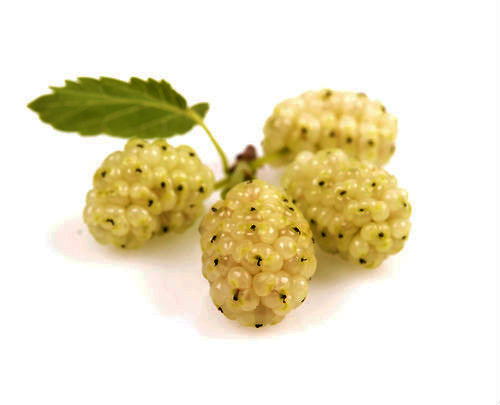- Overview
Common name: Mulberry, Black Mulberry Botanical name: Morus nigra Family: Moraceae Origin Asia Avg. Height X Width: 15' x 15' Varieties: Everbearing, Giant, Pakistani, and White Season: Spring to summer, Everbearing produces throughout the year
Mulberry Tree White Variety in a 3 Gallon Container. Mulberries taste similar to blackberries, and they will stain your hands and lips like black berries as well. They are excellent eaten right out of hand, but they are often used to preserves, jellies, and jams. The leaves of the mulberry are cultivated in many parts of the world as food for silk worms. White mulberries are an Asian favorite.
Physical Characteristics
Habitats
Edible Uses
Medicinal Uses
Other Uses
Cultivation Uses
Propagation
Physical Characteristics
A decidious Tree growing to 10m by 15m at a slow rate. It is hardy to zone 5. It is in flower from May to June, and the seeds ripen from August to September. The flowers are monoecious (individual flowers are either male or female, but both sexes can be found on the same plant)The plant is self-fertile. The plant prefers light (sandy), medium (loamy) and heavy (clay) soils and requires well-drained soil. The plant prefers acid, neutral and basic (alkaline) soils. It can grow in semi-shade (light woodland) or no shade. It requires moist soil. It can tolerate atmospheric pollution.
Habitats
Woodland Garden; Canopy; Secondary; Sunny Edge; Dappled Shade; Cultivars: (as above except) 'Chelsea' 'Wellington'
Edible Uses
Edible Parts: Fruit. Fruit - raw, cooked or used in preserves. A delicious slightly acid flavour, it makes an excellent dessert fruit and can be eaten in quantity. The fruit is juicy and refreshing, though it must be used as soon as it is ripe (from mid-August to September) otherwise it will start to rot. The fruit falls from the tree as soon as it is fully ripe. It is best, therefore, to grow the tree in short grass to cushion the fall of the fruit but to still make it possible to find and harvest. The fruit can also be dried and ground into a powder. The fruit is up to 25mm in diameter.
Medicinal Uses
Anthelmintic; Astringent; Homeopathy; Hypoglycaemic; Laxative; Odontalgic; Purgative. The mulberry has a long history of medicinal use in Chinese medicine, almost all parts of the plant are used in one way or another. The white mulberry (M. alba) is normally used, but this species has the same properties. Recent research has shown improvements in elephantiasis when treated with leaf extract injections and in tetanus following oral doses of the sap mixed with sugar. Analgesic, emollient, sedative. The leaves are antibacterial, astringent, diaphoretic, hypoglycaemic, odontalgic and ophthalmic. They are taken internally in the treatment of colds, influenza, eye infections and nosebleeds. The leaves are collected after the first frosts of autumn and can be used fresh but are generally dried. The stems are antirheumatic, diuretic, hypotensive and pectoral. A tincture of the bark is used to relieve toothache. The branches are harvested in late spring or early summer and are dried for later use. The fruit has a tonic effect on kidney energy. It is used in the treatment of urinary incontinence, tinnitus, premature greying of the hair and constipation in the elderly. Its main use in herbal medicine is as a colouring and flavouring in other medicines. The root bark is antitussive, diuretic, expectorant and hypotensive. It is used internally in the treatment of asthma, coughs, bronchitis, oedema, hypertension and diabetes. The roots are harvested in the winter and dried for later use. The bark is anthelmintic and purgative, it is used to expel tape worms. Extracts of the plant have antibacterial and fungicidal activity. A homeopathic remedy is made from the leaves. It is used in the treatment of diabetes.
Other Uses
Dye; Fibre; Wood. A fibre used in weaving is obtained from the bark. A red-violet to dark purple dye is obtained from the fruit. A yellow-green dye is obtained from the leaves. Wood - used in joinery.
Cultivation Uses
Prefers a warm moist but well-drained loamy soil in a sheltered sunny position. Prefers a light soil. Plants are very tolerant of atmospheric pollution. Trees are hardy as far north as southern Sweden. A slow growing but very ornamental tree, the mulberry is sometimes cultivated in gardens for its delicious edible fruit. The tree is not grown on a commercial scale because the fruit is too soft and easily damaged to allow it to be transported to market, and is therefore best eaten straight from the tree. There are some named varieties. The mulberry takes many years to settle down and produce good crops of fruit, about 15 years being the norm. Trees fruit well in southern and south-western Britain but they require the protection of a wall further north if the fruit is to ripen. This is a good tree for growing grapes into. It means that the grapes are difficult to pick, but they always seem to be healthier and free from fungal diseases. Plants are late coming into leaf and also lose their leaves at the first autumn frosts though the tree in leaf casts quite a dense shade. Mulberries have brittle roots and so need to be handled with care when planting them out. Any pruning should only be carried out in the winter when the plant is fully dormant because mulberries bleed badly when cut. Ideally prune only badly placed branches and dead wood. Once considered to be a very long-lived tree, doubts are now being cast on this assumption, it is probably fairly short-lived. Plants in this genus are notably resistant to honey fungus.
Propagation
The seed germinates best if given 2 - 3 months cold stratification. Sow the seed as soon as it is ripe if possible, otherwise in February in a cold frame. The seed usually germinates in the first spring, though it sometimes takes another 12 months. Prick out the seedlings into individual pots when they are large enough to handle and grow them on in the cold frame for their first winter. Plant them out in late spring or early summer after the last expected frosts. Cuttings of half-ripe wood, 7 - 10cm with a heel, July/August in a frame. Plant out in spring. A good percentage take, though they sometimes fail to thrive. Cuttings of mature wood of the current season's growth, 25 - 30cm with a heel of 2 year old wood, autumn or early spring in a cold frame or a shady bed outside. Bury the cuttings to threequarters of their depth. It is said that cuttings of older wood up to 2.5 metres long can be readily made to strike. The cuttings are taken in February and planted 30cm deep in a shady sheltered position outdoors. The stem is wrapped in moss to prevent water loss by transpiration, with only the top few buds not being covered. Layering in autumn. - Features
weight: 9.99 lbs : - ReviewsThere is no reviews yet...Be the first!
Be the first to write a review of this product!





